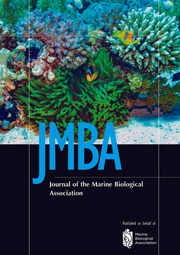Crossref Citations
This article has been cited by the following publications. This list is generated based on data provided by
Crossref.
Chapman, M.G.
and
Clynick, B.G.
2006.
Experiments testing the use of waste material in estuaries as habitat for subtidal organisms.
Journal of Experimental Marine Biology and Ecology,
Vol. 338,
Issue. 2,
p.
164.
Chapman, M.G.
2006.
Intertidal seawalls as habitats for molluscs.
Journal of Molluscan Studies,
Vol. 72,
Issue. 3,
p.
247.
Chapman, Gee
and
Gray, John
2006.
Tony Underwood: A short biography.
Journal of Experimental Marine Biology and Ecology,
Vol. 338,
Issue. 2,
p.
153.
Murdock, Justin N.
and
Dodds, Walter K.
2007.
LINKING BENTHIC ALGAL BIOMASS TO STREAM SUBSTRATUM TOPOGRAPHY1.
Journal of Phycology,
Vol. 43,
Issue. 3,
p.
449.
Johnston, Emma L.
and
Clark, Graeme F.
2007.
Recipient Environment More Important than Community Composition in Determining the Success of an Experimental Sponge Transplant.
Restoration Ecology,
Vol. 15,
Issue. 4,
p.
638.
Walker, Simon J.
Schlacher, Thomas A.
and
Schlacher‐Hoenlinger, Monika A.
2007.
Spatial heterogeneity of epibenthos on artificial reefs: fouling communities in the early stages of colonization on an East Australian shipwreck.
Marine Ecology,
Vol. 28,
Issue. 4,
p.
435.
Beaumont, J. C.
Brown, C. J.
and
Sayer, M. D. J.
2007.
Evaluation of techniques used in the assessment of subtidal epibiotic assemblage structure.
Biofouling,
Vol. 23,
Issue. 5,
p.
343.
Wilhelmsson, Dan
and
Malm, Torleif
2008.
Fouling assemblages on offshore wind power plants and adjacent substrata.
Estuarine, Coastal and Shelf Science,
Vol. 79,
Issue. 3,
p.
459.
Shenkar, Noa
Zeldman, Yael
and
Loya, Yossi
2008.
Ascidian recruitment patterns on an artificial reef in Eilat (Red Sea).
Biofouling,
Vol. 24,
Issue. 2,
p.
119.
Zintzen, Vincent
Norro, Alain
Massin, Claude
and
Mallefet, Jérôme
2008.
Spatial variability of epifaunal communities from artificial habitat: Shipwrecks in the Southern Bight of the North Sea.
Estuarine, Coastal and Shelf Science,
Vol. 76,
Issue. 2,
p.
327.
Miller, Robert J.
and
Etter, Ron J.
2008.
SHADING FACILITATES SESSILE INVERTEBRATE DOMINANCE IN THE ROCKY SUBTIDAL GULF OF MAINE.
Ecology,
Vol. 89,
Issue. 2,
p.
452.
Mineur, Frederic
Johnson, Mark P.
and
Maggs, Christine A.
2008.
Non-indigenous marine macroalgae in native communities: a case study in the British Isles.
Journal of the Marine Biological Association of the United Kingdom,
Vol. 88,
Issue. 4,
p.
693.
Moura, A.
da Fonseca, L. Cancela
Cúrdia, J.
Carvalho, S.
Boaventura, D.
Cerqueira, M.
Leitão, F.
Santos, M. N.
and
Monteiro, C. C.
2008.
Is surface orientation a determinant for colonisation patterns of vagile and sessile macrobenthos on artificial reefs?.
Biofouling,
Vol. 24,
Issue. 5,
p.
381.
Davis, Andrew R.
2009.
Marine Hard Bottom Communities.
Vol. 206,
Issue. ,
p.
19.
Perkol-Finkel, Shimrit
and
Benayahu, Yehuda
2009.
The role of differential survival patterns in shaping coral communities on neighboring artificial and natural reefs.
Journal of Experimental Marine Biology and Ecology,
Vol. 369,
Issue. 1,
p.
1.
Martins, Gustavo M.
Amaral, André F.
Wallenstein, Francisco M.
and
Neto, Ana I.
2009.
Influence of a breakwater on nearby rocky intertidal community structure.
Marine Environmental Research,
Vol. 67,
Issue. 4-5,
p.
237.
Langhamer, Olivia
Wilhelmsson, Dan
and
Engström, Jens
2009.
Artificial reef effect and fouling impacts on offshore wave power foundations and buoys – a pilot study.
Estuarine, Coastal and Shelf Science,
Vol. 82,
Issue. 3,
p.
426.
Dafforn, K. A.
Johnston, E. L.
and
Glasby, T. M.
2009.
Shallow moving structures promote marine invader dominance.
Biofouling,
Vol. 25,
Issue. 3,
p.
277.
Voultsiadou, Eleni
Kyrodimou, Marianthi
Antoniadou, Chryssanthi
and
Vafidis, Dimitris
2010.
Sponge epibionts on ecosystem-engineering ascidians: The case of Microcosmus sabatieri.
Estuarine, Coastal and Shelf Science,
Vol. 86,
Issue. 4,
p.
598.
Cangussu, Leonardo C
Altvater, Luciana
Haddad, Maria Angélica
Cabral, Ana Caroline
Heyse, Halina Linzmeier
and
Rocha, Rosana M
2010.
Substrate type as a selective tool against colonization by non-native sessile invertebrates.
Brazilian Journal of Oceanography,
Vol. 58,
Issue. 3,
p.
219.




